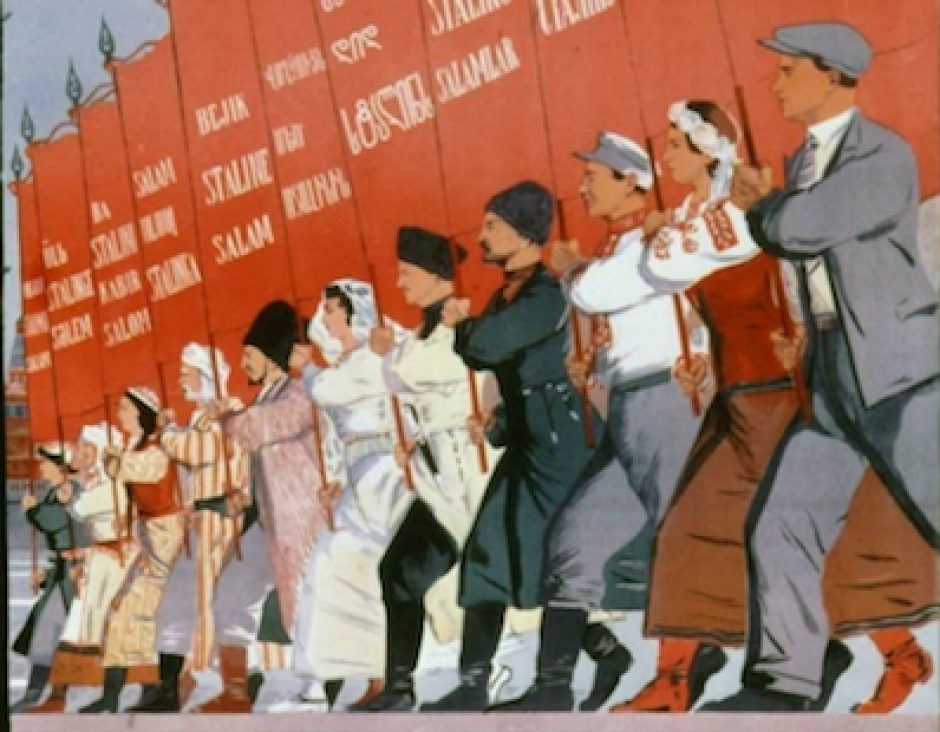Art depicting Ded Moroz
PAGAN ORIGINS AND EARLY VERSIONS
Ded Moroz, meaning “Father Frost”, is a Russian folkloric figure similar to Santa Claus. The figure of Ded Moroz originated in Slavic pagan beliefs as Morozko, an old god or demon who smithed water by creating snow and frost. Morozko was a rather polarized character, known for punishing cruel or lazy people, and rewarding good will and hard work. To some he embodied justice. He had the ability to freeze wrongdoers, though he was always fair and gave second chances. In some incarnations, Morozko would steal children and return them only upon receiving a gift from their parents. It is not entirely clear what parts of his currently known persona are true to the beliefs of pre-Christian pagan Russians and which developed because of interaction with the church.
The introduction of Eastern Orthodox Christianity and influence of Russian literature transformed Morozko into Ded Moroz, a figure who brings children gifts on New Year’s Eve. His clothing was said to be made of flax and embroidered with stars, crosses, and pearls. He wore mittens, a wide belt, a hat, and valenki– felt boots. In many representations he is dressed as a pre-westernization nobleman. Ded Moroz always wielded a pikestaff made of silver or crystal.
Ded Moroz is accompanied by his granddaughter, Snegurochka, a being made up of snow who, in older Russian folklore, was not originally associated with Ded Moroz. Snegurochka rides with Ded Moroz in his troika, a sleigh drawn by three white horses, and helps distribute the presents. They reside in Veliky Ustyug, a town far in the north of Russia.

Snegurochka and Ded Moroz, 1980
ASSOCIATION WITH ST. NIKOLAS
According to some sources, Ded Moroz originates partially from St. Nikolas, who is a patron of travelers, cattle farming, water, and children. St. Nikolas is one of the most revered saints in Russia but is not technically the patron saint of Russia, nor is he the origin of Ded Moroz. Saint Nikolas was born in modern day Turkey and his veneration and syncretization with Ded Moroz is, of course, because of the spread of Christianity.
BOLSHEVIK SECULARIZATION
As the Bolsheviks established their power, they sought to dismantle the Orthodox church’s positioning as a central, incredibly influential body while giving special attention to patriarchal family structures. The practices of Orthodox communities were restricted and the physical spaces of churches redefined. Churches became warehouses and sacred objects made of precious metals were melted down and repurposed. The nuclear family headed by a patriarch was recognized as religiously reinforced and tsarist. The Bolsheviks acknowledged imbalances in power between men and women and attempted to remedy them by giving people the right to divorce, decriminalizing adultery, legalizing abortion, and eliminating legal authority men had over their families. These centralized actions had consequences in more specific manifestations of religion in everyday life.
Because of Ded Moroz’s religious associations, the Bolsheviks decided to ban Ded Moroz and his depictions in 1917. A factor in this decision was Ded Moroz’s apparently bourgeois essence, as well as his reputation as a ‘child’s’ god.
The celebration of Christmas was eliminated in 1929. To further complicate the celebration of holidays, the Bolsheviks transitioned to the Gregorian calendar, as opposed to the Julian calendar on which the Eastern Orthodox church relies. The inconsistency between the two calendars served as another destabilizing force to the church. New Years became the central winter holiday as it had already been secularized (as in, moved from the Orthodox celebration date) by Peter the Great, though the traditional celebrations and decorations were also banned.
SOVIET REINTRODUCTION
About twenty years after the banning of Ded Moroz, Josef Stalin decided to reintroduce Ded Moroz as a uniting figure. In this process, Ded Moroz was given a makeover. The colors of Ded Moroz’s outfit was changed from red to blue and his physique was emphasized as slender and muscular to contrast him from America’s Coca Cola Santa Claus. Associations with St. Nicholas were eliminated as Ded Moroz was supposed to be a secular figure. Instead of Christmas, he and his granddaughter, Snegurochka, came to give out his presents on New Year’s Eve. New Years celebrations again became public.
The reinvented Ded Moroz was brought to the nations of the Soviet Union as a gift bearer and role model of hard work for children. His name was translated into the different languages of the union’s nations. Because he was no longer attached to Christmas, Ded Moroz was introduced without regard to majority religious beliefs of any population. His association with Christianity, Christmas, and Russianness was not lost on the non-Russian peoples of the Soviet Union, however.
WHAT HAPPENED TO HIM
Some countries continue to celebrate Ded Moroz, though others have largely abandoned his recognition, especially those that did not originally recognize him. Ded Moroz is most popular in Russia. In majority Christian countries, Christmas has returned to popular celebration. St. Nikolas has come back from exile in many of these countries. In some majority Muslim countries Ded Moroz is still recognized, but in others the slot of Ded Moroz goes unfilled and ignored. Some people vilify him and see him as a relic of Soviet occupation. According to some sources, Ded Moroz never really caught on anywhere outside of Russia during the Soviet era, which I suppose you can say about a lot of things.
